The Operation of a Three-Bladed Horizontal Axis Wind Turbine under Hailstorm Conditions—A Computational Study Focused on Aerodynamic Performance
Abstract
1. Introduction
2. Computational Methodology
2.1. Blade Geometry, Computational Mesh and Boundary Conditions
2.2. Simulation Procedure
3. Results
3.1. Results of Airflow over HAWT Blade
3.2. Results of Hailstorm Conditions over HAWT Blade
4. Conclusions
Author Contributions
Funding
Institutional Review Board Statement
Informed Consent Statement
Conflicts of Interest
References
- IEA. Global Energy Review 2021; IEA: Paris, France, 2021. [Google Scholar]
- IEA. Electricity Market Report—July 2021; IEA: Paris, France, 2021. [Google Scholar]
- Global Wind Energy Council. Global Wind Report 2021; GWEC: Brussels, Belgium, 25 March 2021. [Google Scholar]
- Du, Y.; Zhou, S.; Jing, X.; Peng, Y. Damage detection techniques for wind turbine blades: A review. Mech. Syst. Signal Process. 2020, 141, 106445. [Google Scholar] [CrossRef]
- Mishnaevsky, L.; Branner, K.; Petersen, H.; Beauson, J.; McGugan, M.; Sørensen, B. Materials for Wind Turbine Blades: An Overview. Materials 2017, 10, 1285. [Google Scholar] [CrossRef]
- Saavedra-Moreno, B.; Salcedo-Sanz, S.; Paniagua-Tineo, A.; Prieto, L.; Portilla-Figueras, A. Seeding evolutionary algorithms with heuristics for optimal wind turbines positioning in wind farms. Renew. Energy 2011, 36, 2838–2844. [Google Scholar] [CrossRef]
- Tang, X.-Y.; Zhao, S.; Fan, B.; Peinke, J. Micro-scale wind resource assessment in complex terrain based on CFD coupled measurement from multiple masts. Appl. Energy 2019, 238, 806–815. [Google Scholar] [CrossRef]
- Sharma, P.K.; Warudkar, V.; Ahmed, S. Application of a new method to develop a CFD model to analyze wind characteristics for a complex terrain. Sustain. Energy Technol. Assess. 2020, 37, 100580. [Google Scholar] [CrossRef]
- Radünz, W.C.; Mattuella, J.M.L.; Petry, A.P. Wind resource mapping and energy estimation in complex terrain: A framework based on field observations and computational fluid dynamics. Renew. Energy 2020, 152, 494–515. [Google Scholar] [CrossRef]
- Makridis, A.; Chick, J. Validation of a CFD model of wind turbine wakes with terrain effects. J. Wind Eng. Ind. Aerodyn. 2013, 123, 12–29. [Google Scholar] [CrossRef]
- Antonini, E.G.; Romero, D.A.; Amon, C.H. Optimal design of wind farms in complex terrains using computational fluid dynamics and adjoint methods. Appl. Energy 2020, 261, 114426. [Google Scholar] [CrossRef]
- Tian, W.; Zheng, K.; Hu, H. Investigation of the wake propagation behind wind turbines over hilly terrain with different slope gradients. J. Wind Eng. Ind. Aerodyn. 2021, 215, 104683. [Google Scholar] [CrossRef]
- Miller, A.; Chang, B.; Issa, R.; Chen, G. Review of computer-aided numerical simulation in wind energy. Renew. Sustain. Energy Rev. 2013, 25, 122–134. [Google Scholar] [CrossRef]
- Ayotte, K. Computational modelling for wind energy assessment. J. Wind Eng. Ind. Aerodyn. 2008, 96, 1571–1590. [Google Scholar] [CrossRef]
- Zajaczkowski, F.J.; Haupt, S.E.; Schmehl, K.J. A preliminary study of assimilating numerical weather prediction data into computational fluid dynamics models for wind prediction. J. Wind Eng. Ind. Aerodyn. 2011, 99, 320–329. [Google Scholar] [CrossRef]
- Liu, Y.; Warner, T.; Liu, Y.; Vincent, C.; Wu, W.; Mahoney, B.; Swerdlin, S.; Parks, K.; Boehnert, J. Simultaneous nested modeling from the synoptic scale to the LES scale for wind energy applications. J. Wind Eng. Ind. Aerodyn. 2011, 99, 308–319. [Google Scholar] [CrossRef]
- Uchida, T.; Ohya, Y. Micro-siting technique for wind turbine generators by using large-eddy simulation. J. Wind Eng. Ind. Aerodyn. 2008, 96, 2121–2138. [Google Scholar] [CrossRef]
- Song, M.; Chen, K.; He, Z.; Zhang, X. Wake flow model of wind turbine using particle simulation. Renew. Energy 2012, 41, 185–190. [Google Scholar] [CrossRef]
- Thumthae, C.; Chitsomboon, T. Optimal angle of attack for untwisted blade wind turbine. Renew. Energy 2009, 34, 1279–1284. [Google Scholar] [CrossRef]
- Rajakumar, S.; Ravindran, D. Iterative approach for optimising coefficient of power, coefficient of lift and drag of wind turbine rotor. Renew. Energy 2012, 38, 83–93. [Google Scholar] [CrossRef]
- Kim, B.; Kim, W.; Lee, S.; Bae, S.; Lee, Y. Development and verification of a performance based optimal design software for wind turbine blades. Renew. Energy 2013, 54, 166–172. [Google Scholar] [CrossRef]
- Bilanin, A. Scaling Laws for Testing of High Lift Airfoils under Heavy Rainfall. In Proceedings of the AIAA 23rd Aerospace Science Meeting, Reno, NV, USA, 14–17 January 1985. [Google Scholar] [CrossRef]
- Dunham, R.; Bezos, G.; Gentry, G.; Melson, E. Two-dimensional wind tunnel tests of a transport-type airfoil in a water spray. In Proceedings of the AIAA 23rd Aerospace Science Meeting, Reno, NV, USA, 14–17 January 1985. [Google Scholar] [CrossRef]
- Hastings, E.; Manuel, G. Scale—Model Tests of Airfoils in Simulated Heavy Rain. J. Aircr. 1985, 22, 536–540. [Google Scholar] [CrossRef]
- Thompson, B.; Jang, J. Aerodynamic Efficiency of Wings in Rain. J. Aircr. 1996, 33, 1047–1053. [Google Scholar] [CrossRef]
- Douvi, D.; Margaris, D.; Davaris, A. Aerodynamic performance of a NREL S809 airfoil in an air-sand particle two-phase flow. Computation 2017, 5, 13. [Google Scholar] [CrossRef]
- Zidane, I.; Saqr, K.; Swadener, G.; Ma, X.; Shehadeh, M. Computational fluid dynamics study of dusty air flow over NACA 63,415 airfoil for wind turbine applications. J. Teknol. 2017, 79, 11877. [Google Scholar] [CrossRef][Green Version]
- Douvi, D.; Douvi, E.; Margaris, D. Computational Study of NACA 0012 Airfoil in Air-Sand Particle Two-Phase Flow at Reynolds Number of Re = 1.76 × 106. Int. J. New Technol. Res. (IJNTR) 2019, 5, 101–108. [Google Scholar] [CrossRef]
- Douvi, E.; Margaris, D. Aerodynamic performance investigation under the influence of heavy rain of a NACA 0012 airfoil for wind turbine applications. Int. Rev. Mech. Eng. (IREME) 2012, 6, 1228–1235. [Google Scholar] [CrossRef]
- Douvi, E.; Margaris, D.; Lazaropoulos, S.; Svanas, S. Low Reynolds Number Investigation of the Flow over a NACA 0012 airfoil at Different Rainfall Rates. Int. Rev. Mech. Eng. (IREME) 2013, 7, 625–632. [Google Scholar] [CrossRef]
- Douvi, E.; Douvi, D.; Pylarinos, D.; Margaris, D. Effect of Rain on the Aerodynamic Performance of a Horizontal Axis Wind Turbine—A Computational Study. Int. J. Energetica (IJECA) 2021, 6, 35–43. [Google Scholar] [CrossRef]
- Woobeom, H.; Jonghwa, K.; Bumsuk, K. Effects of contamination and erosion at the leading edge of blade tip airfoils on the annual energy production of wind turbines. Renew. Energy 2018, 115, 817–823. [Google Scholar] [CrossRef]
- Sapre Sareen, C.A.; Selig, M. Effects of leading edge erosion on wind turbine blade performance. Wind Energy 2014, 17, 1531–1542. [Google Scholar] [CrossRef]
- Zidane, I.; Saqr, K.; Swadener, G.; Ma, X.; Shehadeh, M. On the role of surface roughness in the aerodynamic performance and energy conversion of horizontal wind turbine blades: A review. Int. J. Energy Res. 2016, 40, 2054–2077. [Google Scholar] [CrossRef]
- Pugh, K.; Nash, J.; Reaburn, G.; Stack, M. On analytical tools for assessing the raindrop erosion of wind turbine blades. Renew. Sustain. Energy Rev. 2021, 137, 110611. [Google Scholar] [CrossRef]
- Douvi, D.; Douvi, E.; Plessas, D.; Margaris, D. Numerical Simulation of NACA 0012 Airfoil Operating under Hailstorm Conditions. Int. J. New Technol. Res. (IJNTR) 2021, 7, 73–80. [Google Scholar] [CrossRef]
- Douvi, D.; Georgakopoulos, A.; Lekkas, D.; Douvi, E.; Margaris, D. Aerodynamic Degradation of a Three Bladed Horizontal Axis Wind Turbine Operating During a Hailstorm. In Proceedings of the 8th International Conference on Experiments/Process/System Modeling/Simulation/Optimization (8th IC-EPSMSO), Athens, Greece, 3–6 July 2019. [Google Scholar]
- Somers, D.M. Design and Experimental Results for the S809 Airfoil; National Renewable Energy Laboratory: Golden, CO, USA, 1997. [Google Scholar] [CrossRef]
- Jonkman, B. NREL—National Renewable Energy Laboratory. 3 October 2014. Available online: https://wind.nrel.gov/airfoils/shapes/s809_shape.html (accessed on 30 November 2021).
- Douvi, E.; Margaris, D. Hydrodynamic analysis of a horizontal axis tidal turbine, based on the blade element momentum theory. In Proceedings of the 7th International Conference on Experiments/Process/System Modeling/Simulation/Optimization (7th IC-EpsMsO 2017), Athens, Greece, 5–8 July 2017. [Google Scholar]
- Marten, D.; Wendler, J.; Pechlivanoglou, G.; Nayeri, C.; Paschereit, C. QBlade: An Open Source Tool for Design and Simulation of Horizontal and Vertical Axis Wind Turbines. Int. J. Emerg. Technol. Adv. Eng. 2013, 3, 264–269. [Google Scholar]
- ANSYS®. Academic Research, Release 16.0; ANSYS, Inc.: Canonsburg, PA, USA, 2015. [Google Scholar]
- Menter, F. Two-Equation Eddy-Viscosity Turbulence Models for Engineering Applications. AIAA J. 1994, 32, 1598–1605. [Google Scholar] [CrossRef]
- Federer, B.; Waldvogel, A. Hail and Raindrop Size Distributions from a Swiss Multicell Storm. J. Appl. Meteorol. 1975, 91–97. [Google Scholar] [CrossRef]
- Markowitz, A. Raindrop Size Distribution Expression. J. Appl. Meteorol. 1976, 15, 1029–1031. [Google Scholar] [CrossRef]
- Douglas, R. Hail size distributions. In Proceedings of the 11th Weather Radar Conference, Boulder, CO, USA, 14–18 September 1964. [Google Scholar]
- Taylor, G. The Shape and Acceleration of a Drop in a High-Speed Air Stream. In Technical Report; Batchelor, Cambridge University Press: Cambridge, UK, 1963. [Google Scholar]
- Bauer, L.; Matysik, S. Wind Turbines Database-Wind-Turbine-Models.com. Available online: https://en.wind-turbine-models.com/ (accessed on 25 September 2021).
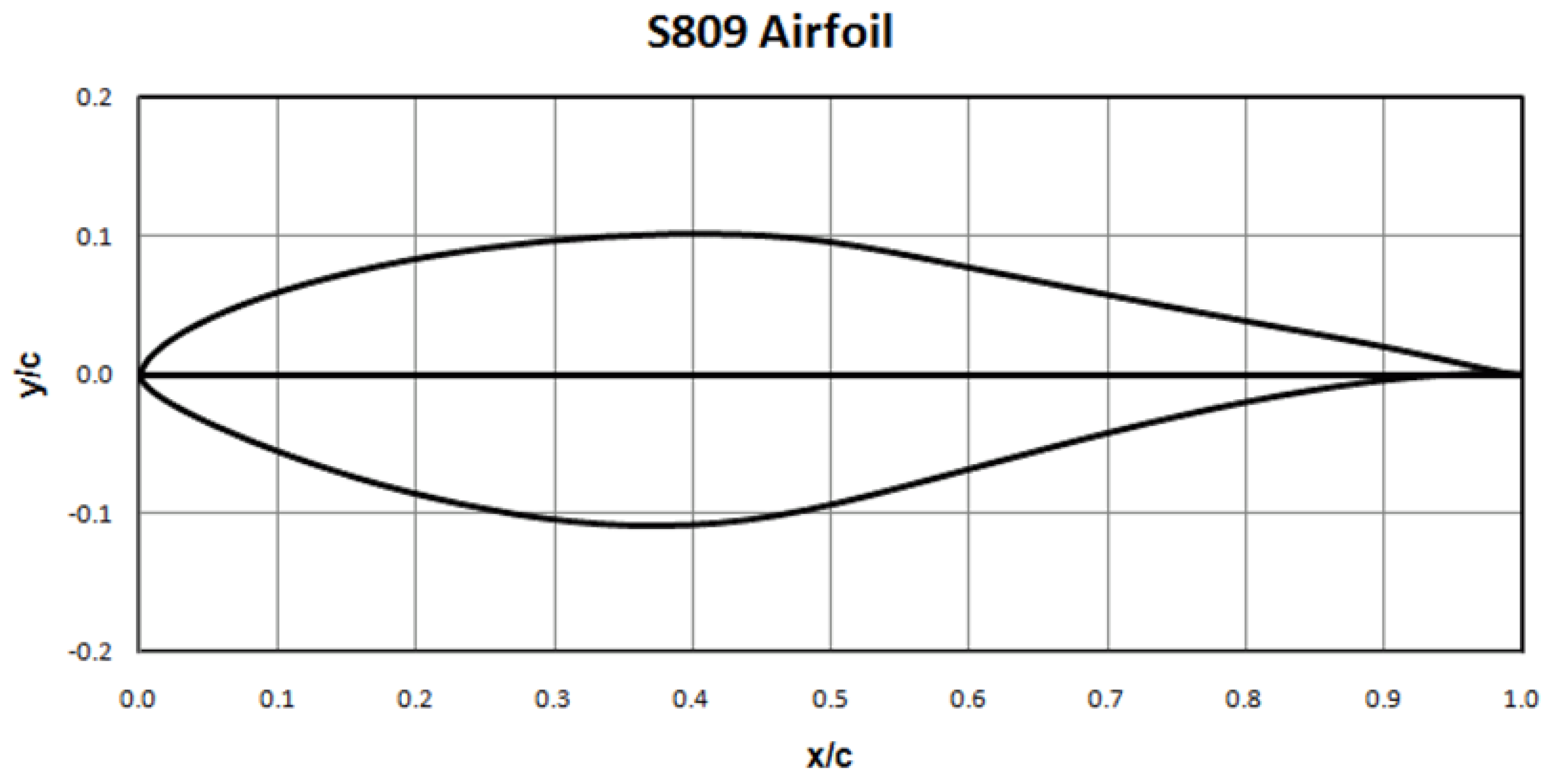



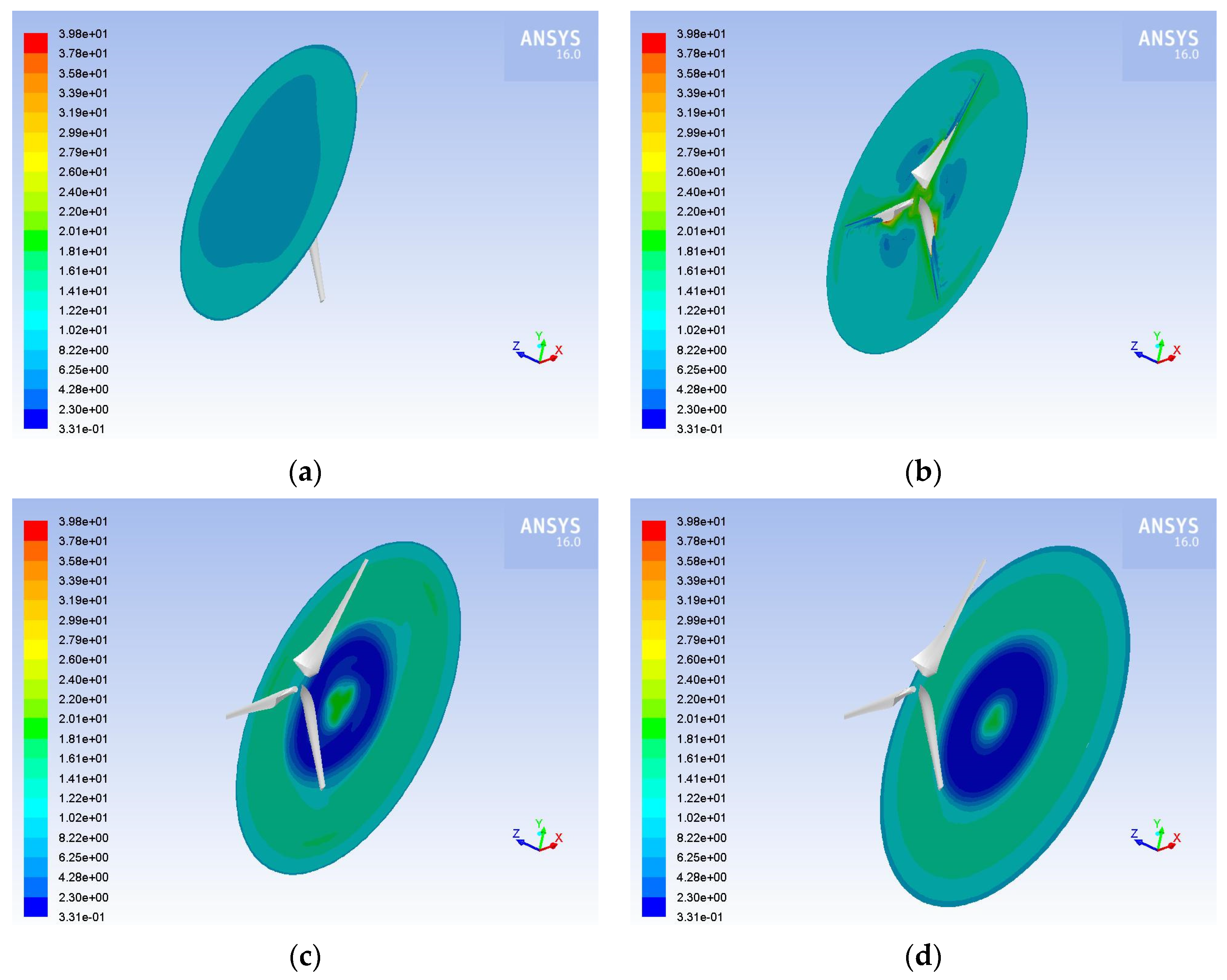
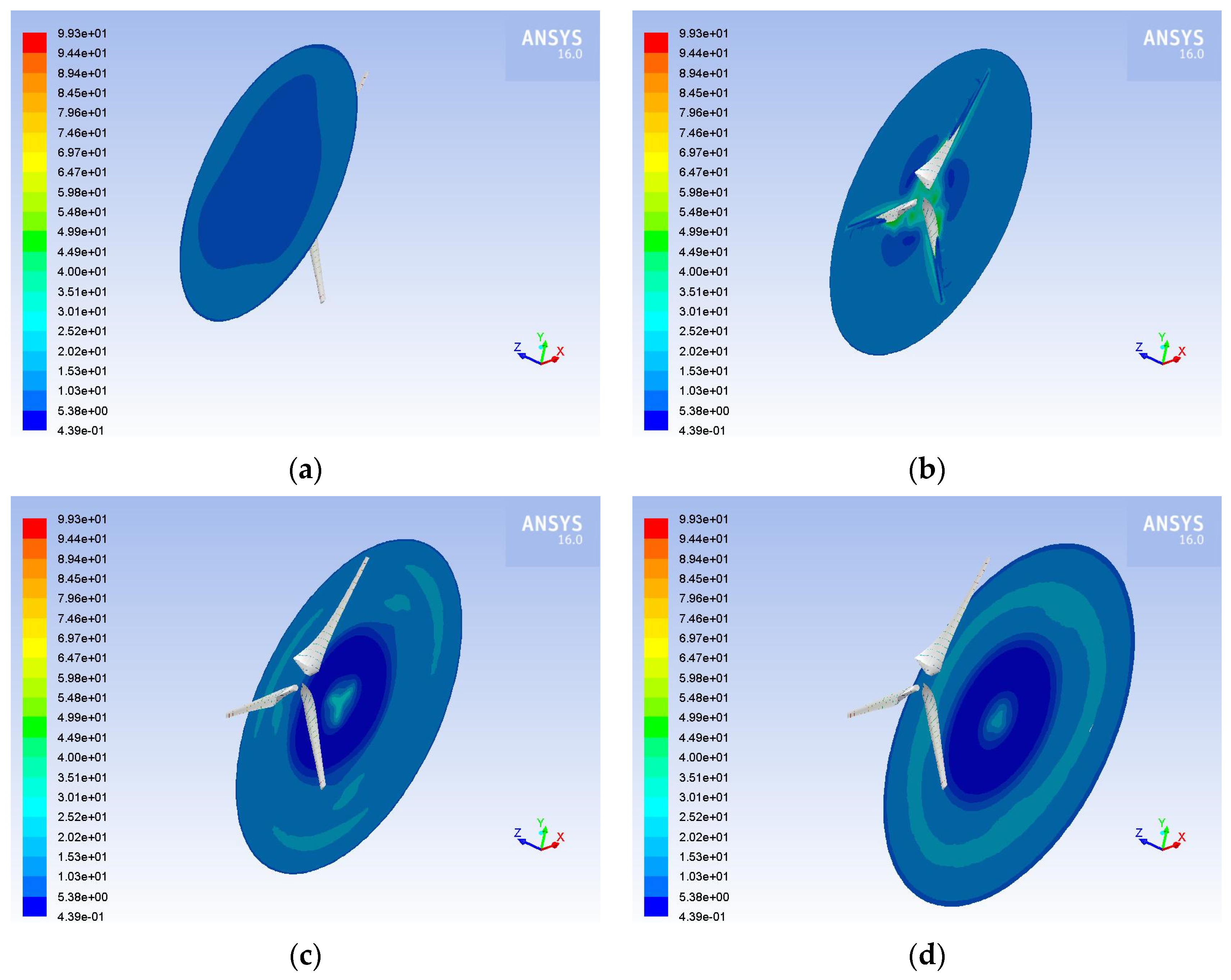
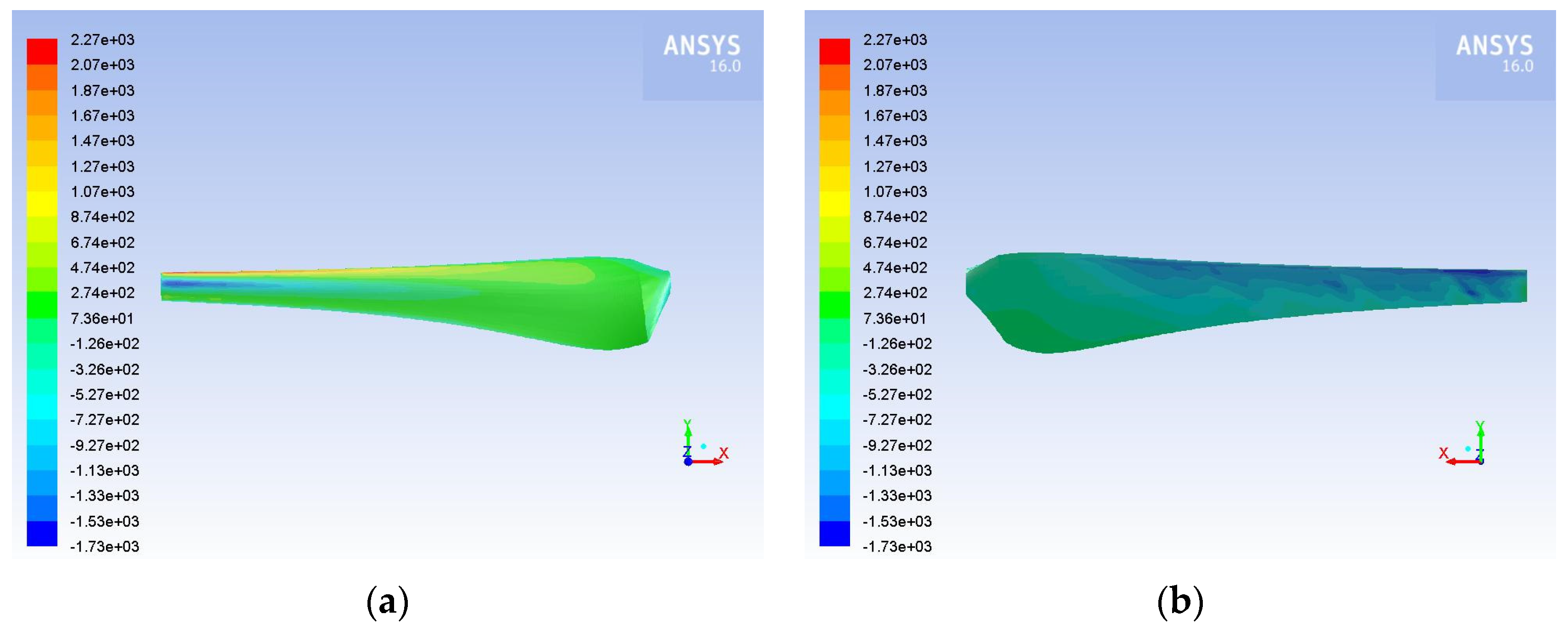
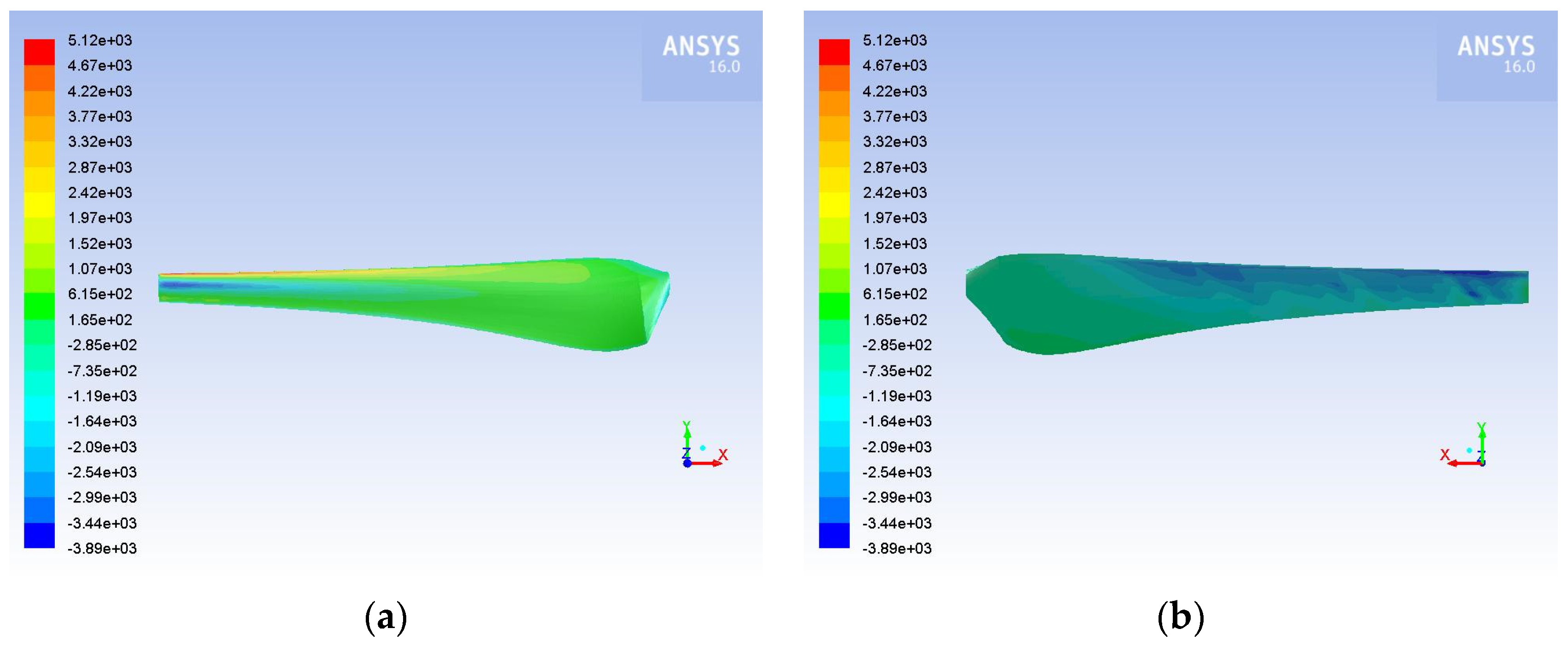
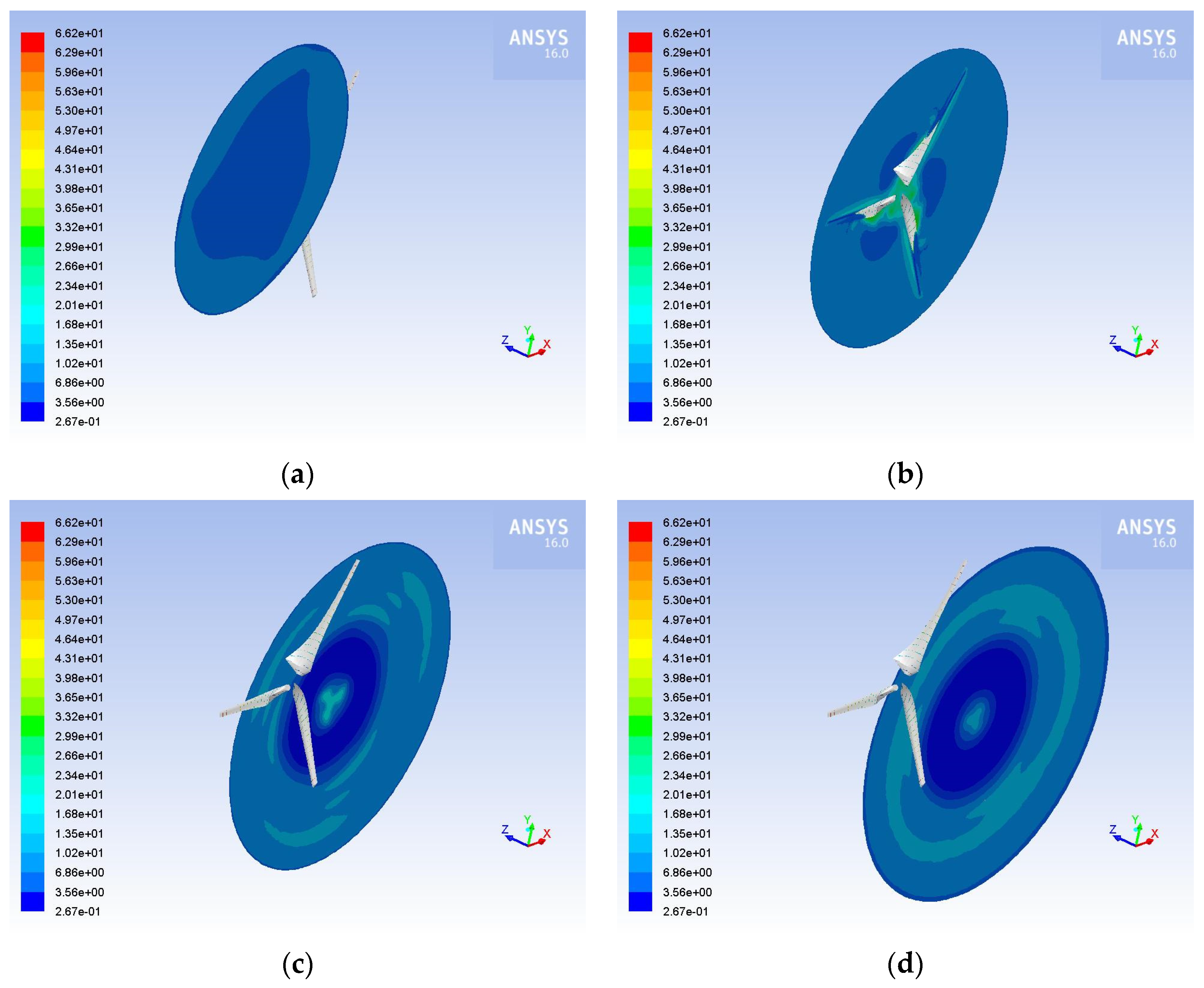
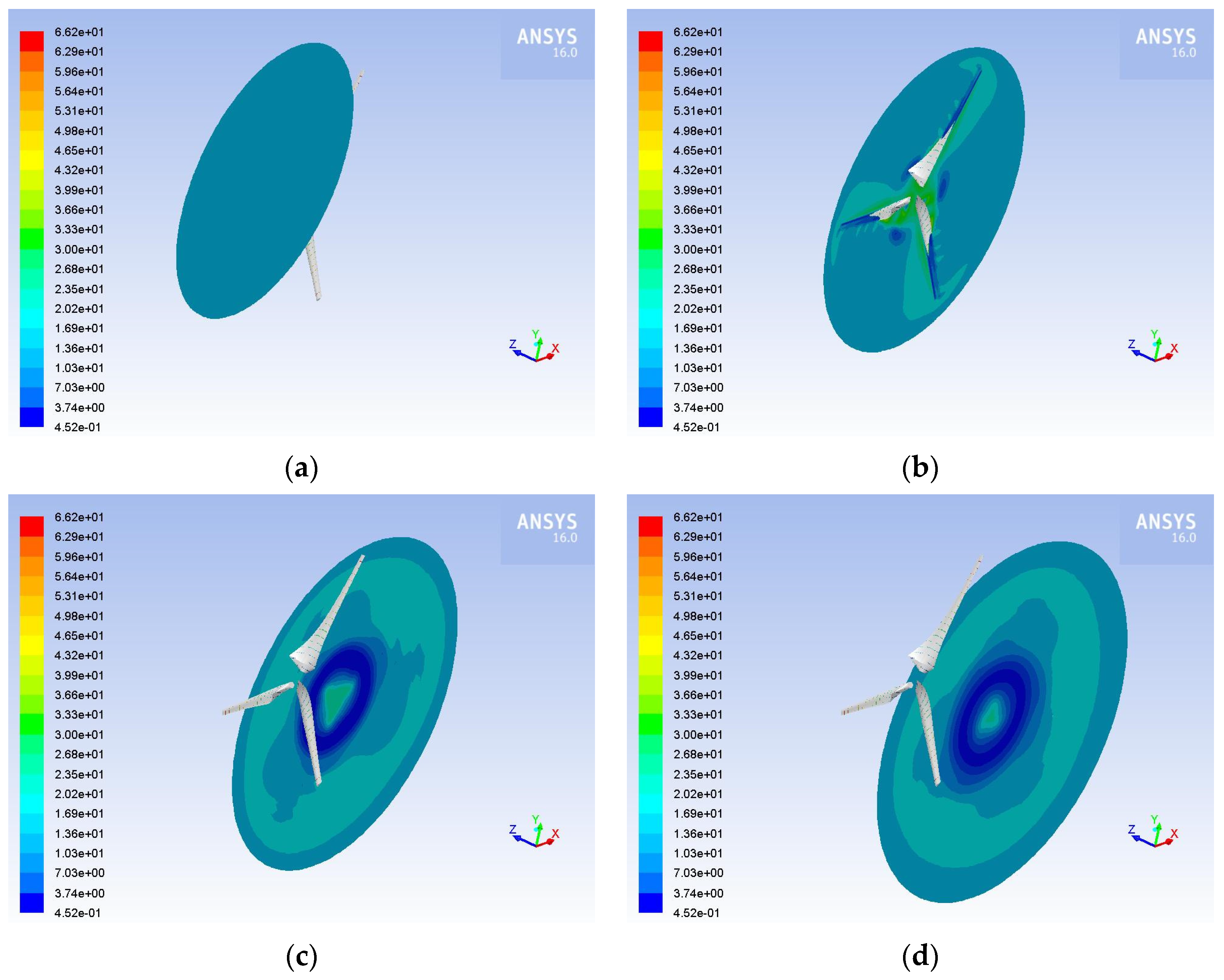



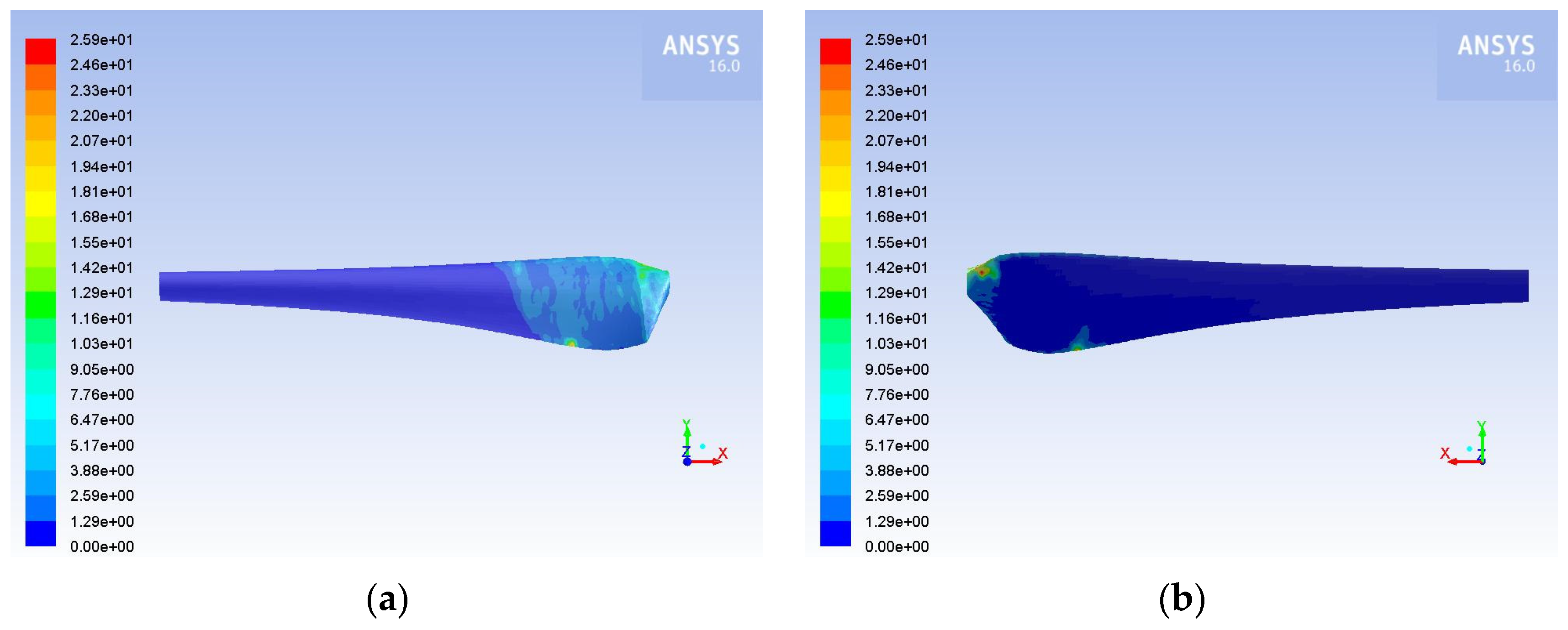

| HAWT Model | HAWT Power Output in MW | |
|---|---|---|
| Present model | TTBEM [40] | 1.660 |
| ANSYS Fluent 16.0 [42] | 1.632 | |
| AMSC, wt1650df [48] | 1.650 | |
| NEG Micon, NM 82/1650 [48] | 1.650 | |
| United Energies, UE 1.65 [48] | 1.650 | |
| Vestas, V82-1.65 [48] | 1.650 | |
| GE General Electric, GE 1.6-82.5 [48] | 1.600 | |
| Air Velocity (m·s−1) | HAWT Power Output in MW | ||
|---|---|---|---|
| TTBEM [40] | ANSYS Fluent 16.0 [42] | Error (%) | |
| 10 | 1.660 | 1.632 | 1.7 |
| 15 | 5.603 | 5.519 | 1.5 |
| Air velocity (m·s−1) | HAWT Power Output in MW | ||
|---|---|---|---|
| Airflow | Hailstorm Conditions | Degradation (%) | |
| 10 | 1.632 | 1.530 | −6.40 |
| 15 | 5.519 | 3.860 | −3.00 |
Publisher’s Note: MDPI stays neutral with regard to jurisdictional claims in published maps and institutional affiliations. |
© 2021 by the authors. Licensee MDPI, Basel, Switzerland. This article is an open access article distributed under the terms and conditions of the Creative Commons Attribution (CC BY) license (https://creativecommons.org/licenses/by/4.0/).
Share and Cite
Douvi, D.; Douvi, E.; Margaris, D.P. The Operation of a Three-Bladed Horizontal Axis Wind Turbine under Hailstorm Conditions—A Computational Study Focused on Aerodynamic Performance. Inventions 2022, 7, 2. https://doi.org/10.3390/inventions7010002
Douvi D, Douvi E, Margaris DP. The Operation of a Three-Bladed Horizontal Axis Wind Turbine under Hailstorm Conditions—A Computational Study Focused on Aerodynamic Performance. Inventions. 2022; 7(1):2. https://doi.org/10.3390/inventions7010002
Chicago/Turabian StyleDouvi, Dimitra, Eleni Douvi, and Dionissios P. Margaris. 2022. "The Operation of a Three-Bladed Horizontal Axis Wind Turbine under Hailstorm Conditions—A Computational Study Focused on Aerodynamic Performance" Inventions 7, no. 1: 2. https://doi.org/10.3390/inventions7010002
APA StyleDouvi, D., Douvi, E., & Margaris, D. P. (2022). The Operation of a Three-Bladed Horizontal Axis Wind Turbine under Hailstorm Conditions—A Computational Study Focused on Aerodynamic Performance. Inventions, 7(1), 2. https://doi.org/10.3390/inventions7010002






